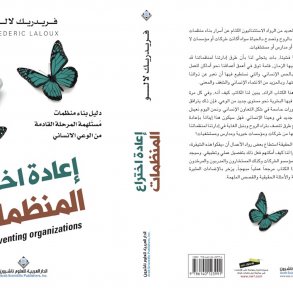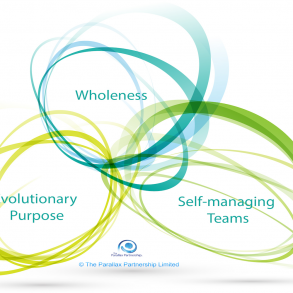![]() Written by Anouk Brack and published at https://www.linkedin.com/pulse/
Written by Anouk Brack and published at https://www.linkedin.com/pulse/
Something has been brewing for a while in organisations and the scales have just tipped. In a fast-paced and fast changing complex world the next step in human evolution is happening right now.
The implications from decades of research on adult development are being applied to business, organizational development and to leadership development. Adult development research has discovered several levels of increasing complexity and care in our value systems and how we look at ourselves and our world. So this research shows us we have not reached our limit when we reach voting age.
Since the global sh*t hit the fan, these new insights are our lifeline
Until recently, supporting this potential growth consciously in our leaders in organisations has not been very important (profit was being made), but priorities have shifted now (since the global sh*t hit the fan). Innovation is more important than ever in the midst of global crises, crushing competitive advantages, and retaining high potentials. It is now vital to the survival of organisations to cultivate an environment of innovation, creativity and a place where the most talented people want to work.
The book that tipped the scales is called Reinventing Organisations by Frederic Laloux
Much work has been done on progressing our human evolution and much work will be done. But the book by Frederic Laloux was the right book at the right time and tipped the scales. The books content was recognized and appreciated by people who had already been working in this field for longer and, more importantly, it was able to reach a much larger and newer audience. The title speaks to our collective pain of having outgrown our organisational structures and a longing for something more humane. The changes that are possible in organisations came to life by real life examples and a clear explanation of the next level of organising ourselves. So there’s a fast growing movement of revolutionaries amongst us that are sooo excited about teal because it finally gives a vision AND evidence of an alternative to the way we have been running organisations (a way that has frankly become too painful for many of us to bare).
I’m warning us for the inevitable mistakes
This is not a book review. I recommend you read the book or watch some videos. This is a list of tips to avoid what will inevitably happen. What starts as a great vision will be implemented unskilfully in places and it will hurt people and hold organisations back. So I was thinking that, because I’ve been immersed in these matters of human and leadership development for 10 years now, I may be entitled to offering some tips to us all, myself included. The tips are most useful perhaps for those excited revolutionaries, but isn’t there one in all of us?
So here are my tips for a revolution of reinventing organisations with little casualties:
- – Remember that someone operating from a higher value system is not of higher value as a person. (Duh, of course not.) However she might be more equipped to make meaning of larger complexity and still act effectively. Got it. And then watch yourself turn around and assume higher is better, again.
- – Don’t get (over)excited about one level like teal and its methodologies and end up making your organization one size fits all. For example tealifying everything and everyone and making all employees take a Theory U workshop with blindfolds and dancing and sh*t. Poor middle management don’t know what hit them. Don’t get me wrong, I do love Theory U and surely a good blindfolded session.
- – Be careful with the use of level assessments. It can have a devastating effect on self confidence when measured lower than expected or lower than (former) peers. It can also have a devastating effect on your amount of friends when you’ve been measured higher than expected (and a little too proud of it).
Of course we can leave out the objective measuring and just do self-assessment. But we all can imagine the influence of high self esteem or high modesty on the results. (The more we know, the more we know we don’t know, am I right?) - – Be aware of conflating different lines of development. Having a teal (=yellow) value system (= worldview) does not mean one’s ego-development or leadership behaviour is on a teal level on a daily basis. Or rather it means it is definitely not. So what line of development is most useful for what purpose?
- – Take the context into account: What’s the complexity of the playing field for an organisation or department and what level of leadership is a good fit for that? Not “higher is better” but the better fit to the context is a better fit. ( 🙁 But I wanna be better than others and save the world and be loved by all humans for all eternity)
- – You can’t force stage-growth. You can support it, even invite it. But you can’t force it. I suspect you can even delay stage development by forcing Sex, Ecology and Spirituality by integral philosopher Ken Wilber on a friend when they’re not ready. So, confession time: When my friend Coen showed me SES (that’s short for Wilbers’ Sex, Ecology and Spirituality) when I was 20 years old and studying biology, I quickly did away with the impending danger to my solid sense of self with the words: ”Anybody who needs so many words to explain something, can’t be of much value.” End of conversation. I (re)discovered Ken Wilber’s work 10 years later having first lived through my “new age period”. It goes to show, you can’t skip levels as much as your loved ones want you too.
- – Look at the whole organization and its purpose, and then how the leadership development, recruiting and the level of complexity that is needed match each other.
- – Look at the centre of gravity of a leader (the level she generally operates from) and the team average and make sure the leader is at least at a level of development half a level to a whole level later. Anybody who’s ever tried to work under a boss with an earlier level of development will still cringe at the thought.
- – There are several lines of developmental stages (also called levels) and the developmental line of one’s value system (or worldview) is only one of them. There are some other very useful ones, like healthy ego-development.
- – The level of development of the top leadership of any organisation is the glass ceiling for all employees. And I don’t mean just have it written down beautifully and compellingly in company strategy and then have it transformed into a youtube video that all employees and the larger network have to watch. No, leadership presence must be lived and practised and they should show up consistently at a certain level of development, also under pressure.
- – Here’s one of my bigger recent insights: What got us from blue (conventional) to orange (modern) is mainly results and profits orientation and high pressure work environment. And that is not what will get us from green (post-modern) to teal (integral). Yes, challenge can drive development but that challenge takes on a different form and it starts to come from the inside out. It’s love driven, not fear-based. So more targets to get to teal? Not gonna work. So unfortunately the high pressure in most organizations to perform and innovate is pushing everyone in exactly the opposite direction! Away from innovation, creativity and positive risk taking and towards the opposite: burnout, narcissistic leadership and gossip and blame culture. (Oh dear.) Development after green, although still triggered by challenges, happens through further relaxation, not contraction. (This is so profound, I can’t even express it clearly at this point. First we spend all this effort becoming someone, then we peel it all off. But what we find then wasn’t there before the process started, it co-evolved. #nevermind #apologiesifIlostyou)
So how do we do get to teal? [drumroll] Enter embodiment
Embodiment or Somatic Intelligence and its basic practice of centering enables us to enter a more resilient flow state. We learn to recognize our reactive patterns easier and recover to our centered self. From a centered self we have more choice over our actions as opposed to when we’re triggered and having only our reactive patterns that are our unique combination of fight, flight, and freeze. These fall back on very early evolutionary parts of ourselves and we have so much more potential. In order to survive as a species and as an organization, if we are to thrive even, we better get educated about stage (or vertical) development soon and adopt state practices that support our growth.
One example of a supporting practice that can be used on different levels of development is Leadership Embodiment. It is both a short-cut as a quick fix (orange), as well as an infinite source of reflection and personal development (green), as well as even as a way to align ourselves with a bigger purpose and get over ourselves and make a bigger contribution (teal and turquoise). So it is both a quick fix for stress management and difficult conversations (blue), a performance improvement (orange) and a lifelong journey towards embodying wholeness and wisdom (teal and turquoise). I am currently researching stage appropriate state practices, to avoid casualties (like managers never ever willing to close their eyes in a training again because of a terribly excited and overshooting mindfulness trainer).
Other examples of possibly supportive practices are sports, martial arts and mindfulness. But not all work as well at each level. Tips for introducing state practices skilfully at different levels of development come in a later blog.
My take-home message:
- Study the evolutionary steps in leadership development and their correlation with organizational development (or invite me for a lunch lecture or masterclass in your office).
- Also realize there is a lot going well intuitively in organizations, these developmental lenses can help you see the big picture clearer and act with more confidence and focus. Build on what is happening already with the intention of making a healthy organisation at all levels.
Maybe if we do this, and stay connected while we experiment, we can avoid too many f*ck ups and make organisations healthy again by building the value systems on top of each other, from the bottom up. Using the newly added and exiting teal system to align everything. Enjoy!
May you experiment wildly and carefully and not force change on others. Instead invite them and make space for their wisdom.





Anouk, your wisdom will save people from much suffering, if they pay attention and “get” what you are saying! I deeply appreciate your writing this article, as I had many of the same things to say, around Teal as a worldview versus as some characteristics of organizations. You’ve saved me much of the effort, so now I can take my time in writing up the rest!!!!